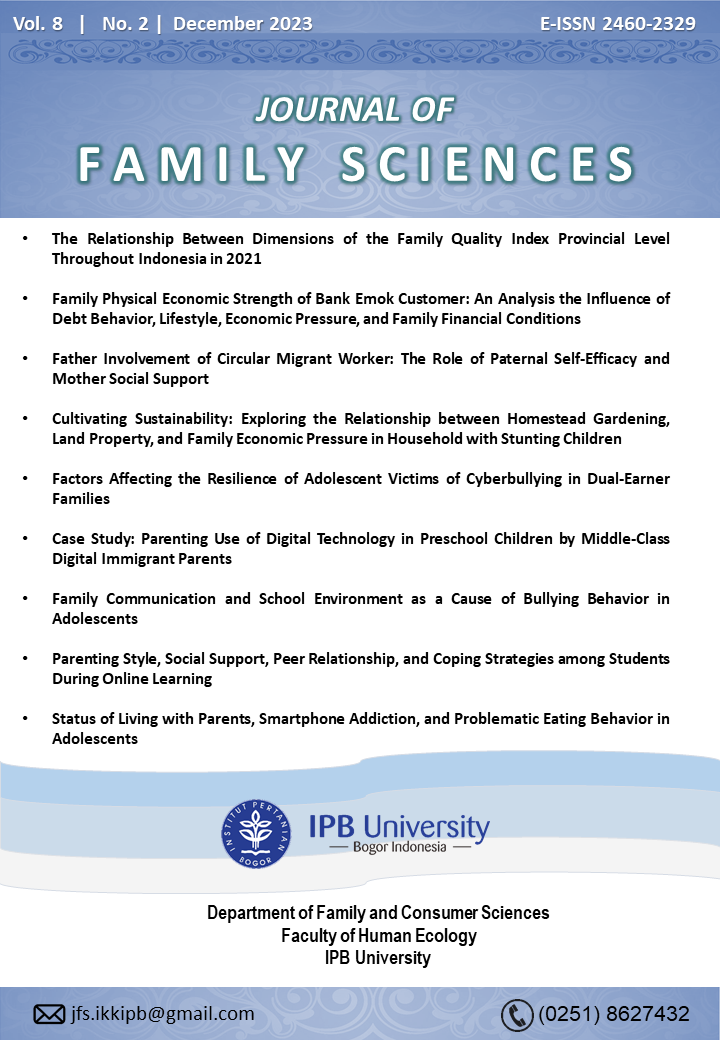Status of Living with Parents, Smartphone Addiction, and Problematic Eating Behavior in Adolescents
Abstract
Excessive intensity of smartphone use can disrupt eating behavior in adolescents. This study aims to analyze the relationship between smartphone addiction and problematic eating behavior. This research involved 230 junior high school students in Jakarta. The research design uses a cross-sectional study. Data were analyzed using Pearson's correlation and Independent Sample T-Test. The results of the Chi-Square test show that the Asymp. Sig. (2-sided) for the smartphone addiction category with a problematic eating behavior category is 0.000 (p<0.05). The correlation test result shows a relationship between the smartphone addiction category and the duration of smartphone use in the morning, afternoon and evening. The Chi-Square Test shows a relationship between the categories of problematic eating behavior and the duration of smartphone use in the morning and afternoon. The Independent Sample T-Test result shows a significant difference in the daily-life disturbance and positive anticipation dimensions between respondents who live with their complete parents (TOL) and those who do not live with their complete parents (TTOL). The result shows a significant positive relationship between smartphone addiction and problematic eating behavior (r=0.711; p=0.000). Adolescents need to raise awareness to use smartphones as needed. In addition, adolescents are advised to adopt healthy eating habits to optimize their growth.
Downloads
References
Ajzen, I. (1991). The theory of planned behavior. Organizational Behavior And Human Decision Processes 50, 179–211 (1991). https://doi.org/10.1016/0749-5978(91)90020-T
Buanasita, A., & Hatijah, N. (2022). Hubungan pola makan, aktivitas fisik, kecanduan internet dengan status gizi anak sma selama masa pandemi covid-19 di Kota Surabaya. Amerta Nutrition, 6(1), 107–116. https://doi.org/10.20473/amnt.v6i1SP.2022.107-116
Budiarti, A., Sustrami, D., & Febriani, V. (2022). The correlation between parenting styles and smartphone addiction among primary school students in Indonesia. International Journal of Nursing and Midwifery Science (IJNMS), 6(1), 96-102. https://doi.org/10.29082/IJNMS/2022/Vol6/Iss1/383
Benbaibeche, H., Saidi, H., Bounihi, A., & Koceir, E. A. (2023). Emotional and external eating styles associated with obesity. Journal of Eating Disorders, 11(1), 1-7. https://doi.org/10.1186/s40337-023-00797-w
Claesdotter-Knutsson, E., André, F., Fridh, M., Delfin, C., Hakansson, A., & Lindström, M. (2021). Gender-based differences and associated factors surrounding excessive smartphone use among adolescents: Cross-sectional study. JMIR Pediatrics and Parenting, 4(4), e30889. https://doi.org/10.2196/30889
Domoff, S., Sutherland, E. Q., Yokum, S., & Gearhardt, A. N. (2020). Adolescents’ addictive phone use: Associations with eating behaviors and adiposity. International Journal of Environmental Research and Public Health, 17(8), 2861. https://doi.org/10.3390/ijerph17082861
Dubois, L., Farmer, A., Girard, M., Peterson, K., & Tatone-Tokuda, F. (2007). Problem eating behaviors related to social factors and body weight in preschool children: A longitudinal study. International Journal of Behavioral Nutrition and Physical Activity, 4, 1–10. https://doi.org/10.1186/1479-5868-4-9
Eriyanti, I. O., Susilo, H., & Riyanto, Y. (2019). Analisis pola asuh grandparenting dalam pembentukan karakter anak di TK Dharma Wanita di Desa Drokilo Kecamatan Kedungadem Kabupaten Bojonegoro. Jpus: Jurnal Pendidikan Untuk Semua, 3(1), 9-16.
Fatima, A., Hastuti, D., & Riany, Y. E. (2021). The influence of parenting and self-control influence toward online gaming among adolescents: the influence of parenting and self-control influence toward online gaming among adolescents. Journal of Family Sciences, 5(2), 138-155. https://doi.org/10.29244/jfs.v5i2.34128
Nurfitriliani, N., Hastuti, D., & Yuliati, L. N. (2019). Parenting style, feeding patterns, and adolescent eating behavior in south Kalimantan between male and female adolescents. Journal of Family Sciences, 4(2), 130-142. https://doi.org/10.29244/jfs.4.2.130-142
Fristanti, Y. M., & Ruhana, A. (2021). Hubungan intensitas penggunaan smartphone terhadap aktivitas fisik dan tingkat konsmsi pangan pada mahasiswa gizi UNESA di era pandemi COVID-19. Jurnal Gizi UNESA, 1(2), 89–94.
Gümüş, D., Sevim, S., & Kızıl, M. (2023). Social media addiction and adolescents: Relationship between social media and eating behaviors during pandemic. Addicta: The Turkish Journal on Addictions, 10(1), 59-66. https://doi.org/10.5152/ADDICTA.2023.22083
Haruna, S. R., Haerani, H., Palayukan, S. S., Ponseng, N. A., Ramdhani, S., & Mondjil, R. (2022). Faktor yang Berhubungan dengan Gadget Addicted pada Anak Usia Sekolah Dasar. Ponorogo (ID): Uwais Inspirasi Indonesia.
Hidayat, W. (2010). Studi empiris theory of planned behavior dan pengaruh kewajiban moral pada perilaku ketidakpatuhan pajak wajib pajak orang pribadi. Jurnal Akuntansi dan Keuangan, 12(2), 82-93. https://doi.org/10.9744/jak.12.2.pp.%2082-93
[IDAI] Ikatan Dokter Anak Indonesia/The Indonesian Pediatrician Association. (2020). Rekomendasi IDAI Selama Anak Menjalani Sekolah Dari Rumah. Retrieved from https://www.idai.or.id/tentang-idai/pernyataan-idai/rekomendasi-idai-selama-anak-menjalani-sekolah-dari-rumah
Jamni, T. (2020). Dampak gawai dan status gizi pada remaja di SMK Negeri 1 Lhoknga dan Poltekkes Aceh 2019. Jurnal SAGO Gizi dan Kesehatan, 1(2), 207-213. https://doi.org/10.30867/gikes.v1i2.417
Jasińska, M., Strzelecka, A., Chmielewski, J., Wolak, P., Stanisławska, I., Choina, P., Kordyzon, M., & Nowak-Starz, G. (2021). Quality of life, health, eating habits and physical development of middle school adolescents in the Świetokrzyskie. Ann Agric Environ Med, 28(4), 659–666. https://doi.org/10.26444/aaem/141624
Joshi, D. R., Neupane, U., Singh, J., Khanal, B., & Belbase, S. (2021). Effects of using digital devices on food consumption among university students in Nepal. International Research Journal of MMC (IRJMMC), 2(4), 36–54. https://doi.org/10.3126/irjmmc.v2i4.41552
Kebede, W. A., & Ayele, B. Y. (2021). Magnitude of stunting and associated factors among adolescent students in Legehida District, Northeast Ethiopia. Journal of Nutrition and Metabolism, PMC8536425. https://doi.org/10.1155/2021/2467883
Kim, K. M., Lee, I., Kim, J. W., & Choi, J. W. (2021). Dietary patterns and smartphone use in adolescents in Korea: a nationally representative cross-sectional study. Asia Pacific Journal of Clinical Nutrition, 30(1), 163-173. https://doi.org/10.21203/rs.3.rs-33267/v1
Kim, Y., Lee, N., & Lim, Y. (2017). Gender differences in the association of smartphone addiction with food group consumption among Korean adolescents. Public Health, 145, 132–135. https://doi.org/10.1016/j.puhe.2016.12.026
Kurniawan, H., & Farapti. (2021). Hubungan adiksi internet dengan status gizi pada mahasiswa Fakultas Kesehatan Masyarakat Universitas Airlangga. Media Gizi Kesmas, 10(2), 187-195. https://doi.org/10.20473/mgk.v10i2.2021.187-195
Kwon, M., Kim, D. J., Cho, H., & Yang, S. (2013). The smartphone addiction scale: Development and validation of a short version for adolescents. PLoS ONE, 8(12), 1–7. https://doi.org/10.1371/journal.pone.0083558
Lestari, R., & Sulian, I. (2020). Faktor-faktor penyebab siswa kecanduan handphone studi deskriptif pada siswa di SMP Negeri 13 Kota Bengkulu. Consilia : Jurnal Ilmiah Bimbingan dan Konseling, 3(1), 23–37. https://doi.org/10.33369/consilia.v3i1.9473
Lim, S., Kim, M., & Choi, M. (2016). Dietary life status according to smart device use of university students in Korea. The Korean Journal of Food And Nutrition, 29(3), 363–370. https://doi.org/10.9799/ksfan.2016.29.3.363
Manzoor, A., Basri, R., Ali, I., Javaid, S., Amjad, M., Amin, U., & Kamran, H. (2020). Smartphone addiction/overuse and its effect on dietary behavior and lifestyle-a systematic review. EAS J Nutr Food Sci, 2, 289-97. https://doi.org/10.36349/easjnfs.2020.v02i05.007
Metbulut, A. P., Özmert, E. N., Teksam, O., & Yurdakök, K. (2018). A comparison between the feeding practices of parents and grandparents. European Journal of Pediatrics, 177, 1785-1794. https://doi.org/10.1007/s00431-018-3244-5
Omera Naseer, F. M., Fazil, M., Bilal, S., Kulsoom, A., Naseer, S. H. O., Mahmood, F., ... & Hamid, S. (2018). Eating habits of adolescent students. Journal of Rawalpindi Medical College, 22(4), 357-360.
Noerfitri, N., & Aulia, P. A. (2021). Perilaku makan dan kejadian gizi lebih pada mahasiswa STIKes Mitra Keluarga. Jurnal Penelitian Kesehatan" SUARA FORIKES"(Journal of Health Research" Forikes Voice"), 13, 94-99. http://dx.doi.org/10.33846/sf13nk118
Nurdiani, R., Syifa Rahman, N. A., & Madanijah, S. (2023). Perilaku makan tipe emotional, external dan restrained kaitannya dengan indeks massa tubuh mahasiswa. Jurnal Ilmu Gizi dan Dietetik, 2(1), 59-65. https://doi.org/10.25182/jigd.2023.2.1.59-65
Prianugraha, K. A. M., Widiarta, G. B., & Aryawan, K. Y. (2022). Pengalaman adiksi smartphone pada remaja di Kabupaten Buleleng. MIDWINERSLION: Jurnal Kesehatan STIKes Buleleng, 7(2), 8–18. https://doi.org/10.52073/midwinerslion.v7i2.264
Puspitawati, H., & Herawati, T. (2013). Metode Penelitian Keluarga. Bogor(ID): IPB Press.
Putri, K., Y. (2018). Gambaran theory of planned behavior (TPB) pada perilaku sarapan pagi mahasiswa alih jenis Fakultas Ekonomi dan Bisnis, Universitas Airlangga. Jurnal Promkes, 6(1), 80–92. https://doi.org/10.20473/jpk.V6.I1.2018.80-92
Rahman, N., Dewi, N. U., & Armawaty, F. (2016). Faktor - faktor yang berhubungan dengan prilaku makan pada remaja SMA Negeri 1 Palu. Jurnal Preventif, 7(1), 1–64. Retrieved from http://jurnal.untad.ac.id/jurnal/index.php/Preventif/article/view/5818/4576
Ramdhani, N. (2011). Penyusunan alat pengukur berbasis theory of planned behavior. Buletin Psikologi, 19(2), 55 – 69. http://dx.doi.org/10.22146/bpsi.11557
Reviani, N., & Riany, Y. E. (2022). Establishing healthy eating habits during child development to reduce the prevalence of obesity: establishing healthy eating habits during child development to reduce the prevalence of obesity. Journal of Family Sciences, 7(2), 88-101. https://doi.org/10.29244/jfs.v7i2.43540
Strien, T., Frijters, J., Bergers, G., & Defares, P. (1986). The Dutch Eating Behavior Questionnaire (DEBQ) for assessment of restrained, emotional, and external eating behavior. Archives of Pharmacal Research, 5(2), 295–315. https://doi.org/10.1002/1098-108X(198602)5:2%3C295::AID-EAT2260050209%3E3.0.CO;2-T
Wijaya, K. (2019). Hubungan intensitas penggunaan smartphone dengan perilaku makan pada emerging adults. Calyptra: Jurnal Ilmiah Mahasiswa Universitas Surabaya, 8(1), 1606–1616. Retrieved from https://journal.ubaya.ac.id/index.php/jimus/article/view/3833/2940
Authors who publish with this journal agree to the following terms:
- Authors retain copyright and grant the journal right of first publication with the work simultaneously licensed under

This work is licensed under a Creative Commons Attribution 4.0 International License. that allows others to share the work with an acknowledgement of the work's authorship and initial publication in this journal. - Authors are able to enter into separate, additional contractual arrangements for the non-exclusive distribution of the journal's published version of the work (e.g., post it to an institutional repository or publish it in a book), with an acknowledgement of its initial publication in this journal.
- Authors are permitted and encouraged to post their work online (e.g., in institutional repositories or on their website) prior to and during the submission process, as it can lead to productive exchanges, as well as earlier and greater citation of published work (See The Effect of Open Access).



_001.png)



